Country toilet without a cesspool. Do-it-yourself country toilet without a cesspool. Concrete or plastic septic tanks
Lovers of pastime in the country are faced with the problem of arranging a toilet. Many in the old fashioned way build a small booth with cesspool, but times are changing, and ancient structures are being replaced by new technologies that allow you to buy and use a dry closet for a summer residence without pumping out.
What is a dry closet
In appearance, the dry closet in the country is similar to the usual toilet in the apartment. The only difference is that it is enclosed in a plastic container. The design consists of a small drain tank and a reservoir that contains microorganisms. The dry closet for giving without smell and pumping out is eco-friendly. This is its main advantage. Waste that gets inside is recycled, for which special bacteria are responsible.
An odorless toilet in a country house also has its drawbacks - sooner or later it has to be cleaned. Fortunately, this is not done so often, and depends on the volume of the container and the number of visits. In addition, recycled waste products do not have a specific smell, and, depending on the processing method, which will be discussed in more detail below, they can be used for household needs as fertilizer.
How does a dry closet work for a summer residence
The design is completely independent and does not need sewerage and water supply. The principle of operation of a dry closet for odorless and pumping is simple: clean water is poured into a special tank, which is used to flush sewage. All this is diverted to a special tank located at the bottom of the structure, where special bacteria are taken to work. They not only decompose waste products, but also relieve them of the smell. In addition, the dry closet is equipped with a non-return valve that does not allow odors to penetrate outside.
Types of dry closets
Devices are performed in different versions, so they can be divided into several types. According to the method of mobility, it is customary to distinguish the following types of dry closets without pumping:
- Mobile. Structures consisting of two modules, the first of which is a container with water and the seat itself, and the second is a drive.
- Semi-stationary. Outwardly, they have the same dimensions as the usual toilets, with the only difference being that they use a drive, and not a sewer outlet.
- Stationary. Rarely seen in home gardens. They are installed in places with a large crowd of people: in markets, parking lots, in places of mass celebrations, etc.
According to the type of functioning, three groups of dry closets can be distinguished:
- peat;
- chemical;
- electrical.
Peat dry closet
Environmentally friendly components are used to process waste products. It can be peat (moreover, the usual one will not work - you need to use a special one with a large number of microorganisms), sawdust, etc. The essence of its work is simple: a peat mixture is scattered on the waste, the organisms inside which force it to be processed. Recycled material can be used as plant food, after preparing it in the compost pit.
The dry closet peat is also called composting. It does not require pumping and can be installed indoors or outdoors. If it is assumed that more than two people will continuously use it, then it is advisable to make a drain for the outflow of liquid and install a ventilation window or a vent pipe to remove specific odors. The toilet is emptied as it accumulates, although you can do it at your own discretion.
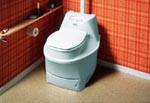
Electric dry closet
He managed to win fame not only abroad, but also in Russia. To power an electric dry closet, you need a voltage of 220 V and a grounded socket. The principle of operation of the device is simple: waste is separated into liquid (discharged through a special hose) and solid, which are dried and, as the tank is filled, disposed of or used as fertilizer. The installation of a bio-toilet implies the arrangement of exhaust ventilation in without fail.
Chemical dry closet
In most cases, a chemical dry closet is a small device that is very comfortable to use, since it does not require ventilation and pumping. It consists of two compartments, a chemical reagent is poured into the lower one, disinfecting waste products and blocking odors. Among chemical dry closets, a cassette version is distinguished. It is installed permanently, and the sewage container is located in the rear compartment of the cabin behind the door.
How to use a home dry closet
A simple layman should not have a question about how to use a dry closet for a summer residence, since the process is practically the same as using an ordinary toilet bowl. Immediately after using the dry closet, you need to wash off the sewage. For this, an electric pump or damper is used that supplies water. In a compost peat toilet, a mixture of peat or other natural absorbent is used for this purpose.
When filling the waste container, it must be emptied, since pumping is not provided here. The frequency of this action, judging by the reviews, depends solely on the size of the receiver and the number of people using the device. In liquid models, a special indicator is used to indicate that the drive is full. After draining the sewage, the bio-toilet must be washed and reinstalled.
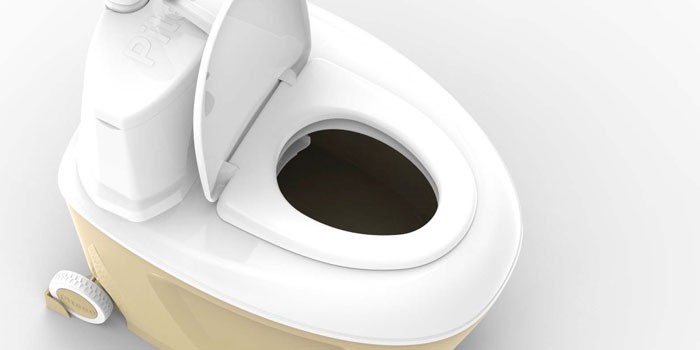
How to choose a dry closet for a summer residence
Each model has both undeniable advantages and disadvantages. When buying a dry closet, you should choose the recycling method that suits the available opportunities. This indicator depends on the presence of water supply, sewerage (septic tank) on the site. It will also be important to have ventilation in the room where the toilet will be placed. Reviews indicate that when purchasing a peat or compost option, it is worth considering whether it will be possible to deliver the absorbent to the location of the toilet.
In addition to width, height, depth and color, the choice of a dry closet for giving without pumping out is also influenced by other characteristics that should be paid attention to. It is necessary to determine the place of installation, because different types Bio-latrines require different communications. So, for peat, you only need to arrange ventilation, when an electrical outlet will be required. Portable ones are easy to move, while stationary ones require a permanent place - you need to take care of this. With regards to manufacturers, Finnish and Norwegian ones have proven themselves well, although domestic ones are also not far behind.
Types of dry closets
There are many parameters based on which dry closets can be divided into types and types. However, from all the characteristics, one main one can be distinguished, according to which all toilets can be delimited into bio-toilets with water flush and devices that do not use water. The first type includes all devices consisting of two parts, the upper of which is designed for water. The second group of devices is suitable when it is not possible to equip the sewer. Peat or the like is used as the absorbent element.
Processing method
The main parameter that affects not only the price of a dry closet, but also the choice is the method of processing human waste. There are several types:
- compost;
- mechanical with biofilm;
- peat;
- chemical;
- electrical.
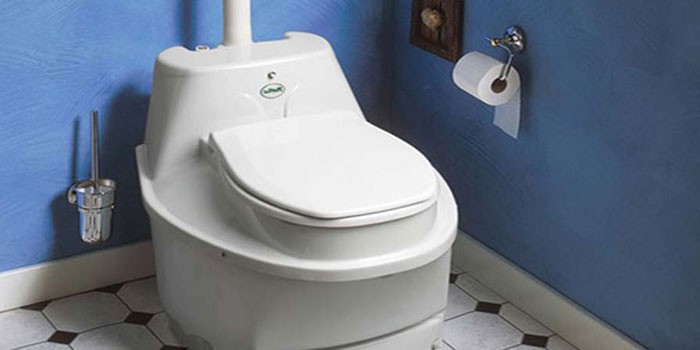
How many people is it for
When choosing a particular model, it is important to pay attention to how many people the device is designed for. This parameter will determine how often the device will have to be emptied, and whether it will cause trouble, because pumping is not provided for in the designs. After all, as you know, the larger the receiver, the less often it will have to be serviced and the more people will be able to use it. Therefore, giving preference to one or another model, it is important to be aware of the amount of work that will have to be done when servicing the device.
Type of electric dry closet
The most expensive device on the market today is an electric dry closet. Its lower tank is divided into two parts, one of which is designed to collect liquid waste, and the second is used for solid waste. Liquid waste goes through a hose into the sewer, while solid waste is recycled. Thanks to such a system, this type of dry closet does not have to be serviced and emptied frequently. This will need to be done 2-3 times a year. The big plus of the toilet is the absence of the need to buy consumables for waste recycling - electricity will take care of this.
All electric bio-toilets can be divided into the following groups:
- cassette;
- with waste freezing;
- compost;
- with combustion chamber;
- with separate waste collection.
Period of use
This indicator will directly depend on the number of people who will use the dry closet, therefore, if in a family or where the device will be used, a large number of visits to the restroom, you should choose a model with a large storage tank in advance, otherwise you will have to clean it very often, since there is no pumping in it. It is worth remembering that manufacturers indicate in the instructions the period of use, calculated per person with an average number of visits. This indicator ranges from 30 to 140 days.
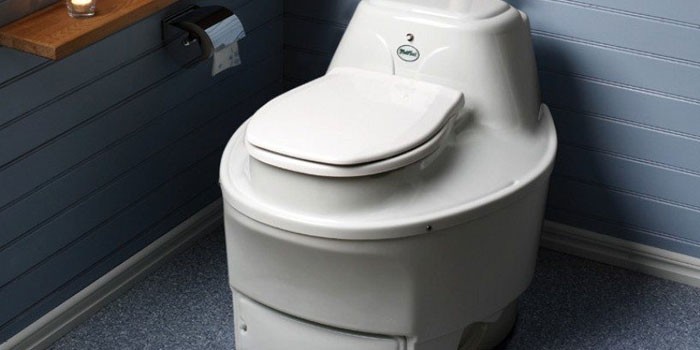
Top tank volume
Bio-toilet consists of two tanks connected to each other. In the upper, which is in most cases a seat, liquid is poured or peat is poured. In addition, the container is equipped with a pump, with the help of which sewage is washed away. There are models in stores, the volume of the upper tank of which varies from 7 to 33 liters. This is enough to maintain the structure.
Bottom tank volume
When choosing a stationary dry closet, this parameter is of no fundamental importance, but if you take a portable option, then you should think about it. One of the main points will be the weight of the filled apparatus, because you will have to carry it out yourself. On the other hand, if the volume is insufficient, then you will have to clean the toilet bowl too often, which can create discomfort.
flush
When buying a toilet, you should pay special attention to the flushing system, since this component of the system affects the hygiene and cleanliness of the device itself. In addition, it blocks the spread of odors. Many samples are equipped with a water flush. This is very convenient, especially since some models can be connected to the water supply, while others are filled autonomously.
flush mechanism
To ensure flushing in bio-toilets, a pump is used, located in the upper tank. There are three types:
- piston;
- bellows;
- electric pump.
Rating of dry closets for summer cottages
Model name:
- Thetford Porta Potti 365.
- 5440-9340 rubles.
Product Features:
- top tank 15 l;
- flushing with water;
- liquid;
- lower tank full indicator;
- storage tank 21 l;
- portable;
- piston pump;
- chemical toilet;
- 38.3×41.4×42.7 cm.
- inexpensive.
- the need to use expensive liquids.
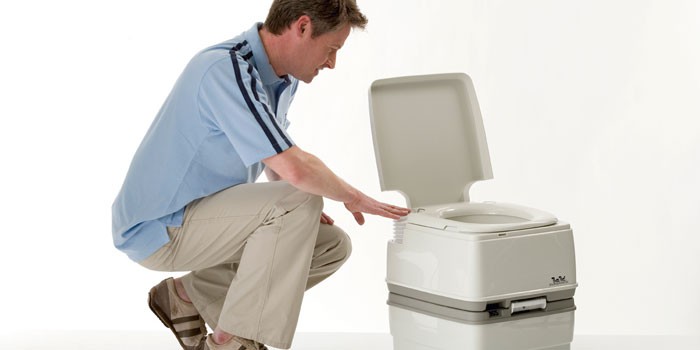
Model name:
- Piteco 506.
- from 5590 rubles.
Product Features:
- storage tank 44 l;
- stationary;
- dry flush;
- 39×59×71 cm.
- inexpensive;
- comfortable in using.
- not a very reliable peat spreading mechanism.
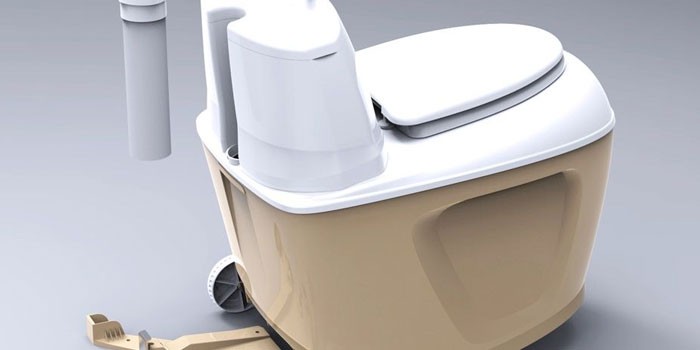
Model name:
- Thetford Porta Potti Excellence Electric.
- 9030-13995 rubles.
Product Features:
- dry closet chemical;
- top tank 15 l;
- flushing with water;
- liquid;
- pressure relief valve;
- storage tank 21 l;
- portable;
- electric pump;
- 33.8×44.8×45 cm.
- Beautiful design;
- compact.
- the receiving tank fills up quickly.
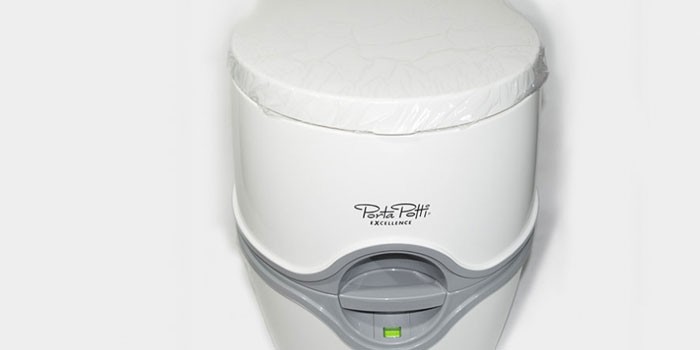
Model name:
- Bioecology Ecolight Summer resident.
- 14900-15900 rubles.
Product Features:
- dry closet compost peat;
- body made of polyethylene;
- storage tank 225 l;
- toilet cabin;
- 115×230×115 cm.
- large receiving tank.
- big sizes.
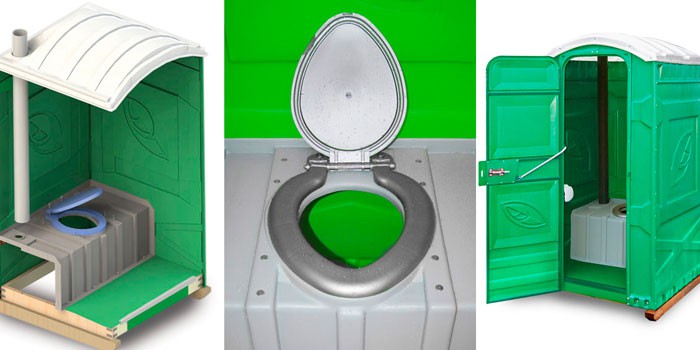
Model name:
- Separett Villa 9011.
- 31980-34800 rubles.
Product Features:
- dry closet electric;
- body made of polystyrene;
- storage tank 23 l;
- with separate collection of waste;
- stationary;
- 45.6×54.1×67.2 cm.
- large storage tank;
- year-round use.
- can only be used in a seated position.
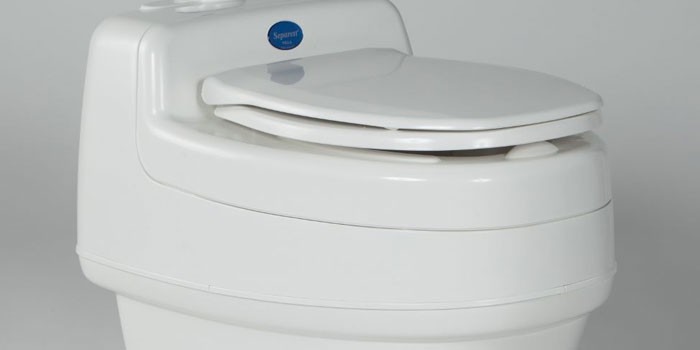
Model name:
- Enviro 20.
- 4773-5180 rubles.
Product Features:
- dry closet chemical;
- top tank 10 l;
- flushing with water;
- storage tank 20 l;
- portable;
- bellows pump;
- 36.5×42×41.5 cm.
- cheap.
- for full use, special fillers for splitting waste are needed.
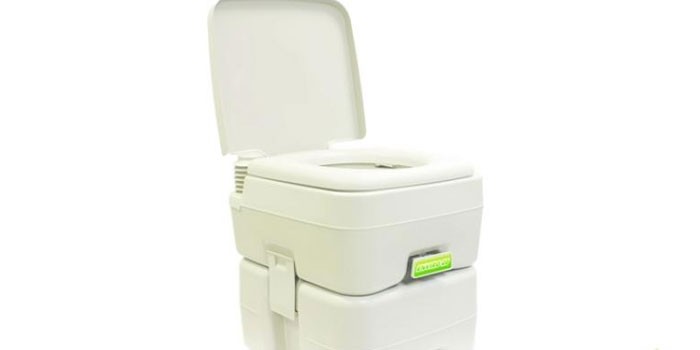
Model name:
- BioLet 25.
- 95800-104500 rubles.
Product Features:
- automatic mixing of compost;
- dry closet electric;
- built-in fan;
- compost;
- stationary;
- 55×65×71 cm;
- Ease of use.
- high price.
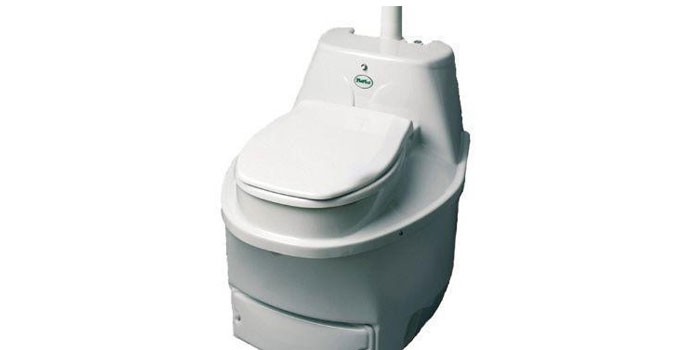
Model name:
- Kekkilä Ekomatic/Ekomatic 50.
- 9500-18500 rubles.
Product Features:
- dry closet compost peat;
- storage tank 50 l;
- period of use 30 days;
- stationary;
- 50×47×51 cm.
- great quality.
- not quite reliable components for models made in Russia.

Model name:
- Cinderella (Cinderella).
- from 200,000 rubles.
Product Features:
- top tank 15 l;
- storage tank 21 l;
- portable;
- toilet electric;
- 38.5×59×58.5 cm.
- easy to install;
- small-sized.
- high price.
Model name:
- BIO COMFORT Plus.
- from 10000 rubles.
Product Features:
- top tank 12.5 l;
- storage tank 40 l;
- portable;
- peat, composting;
- lower tank full indicator.
- large volume of the receiving tank.
- short service life.
Video: Odorless country toilet
Any owner of a summer house wants the rest on the site to be as comfortable as possible. For these purposes, in the absence of a central sewage system, a toilet is made. But constantly cleaning it and pumping out accumulated waste is not a particularly pleasant experience. So, in this article we will look at better ways how to make a toilet for giving without smell and pumping out.
A comfortable toilet will greatly facilitate your stay in the country
- Quite a high finite cost of use - the pit is regularly filled and requires constant cleaning, which implies frequent high costs.
- Over time, the walls of the pit tend to collapse and, as a result, the accumulated waste penetrates directly into the soil and ground water, thereby depriving you of the opportunity to fully use the well or source.
- There is often an unpleasant smell near the toilet, which makes staying in the building unbearable.
Thus, cesspools have quite a few shortcomings that can be easily eliminated when considering other options for arranging country toilets.
Toilet for giving without smell and pumping out: three possible solutions
There are three possible options building a toilet without the need for pumping. All of them fundamentally differ from each other in terms of final cost, expediency in connection with the time of residence on the site and summer cottage conditions, therefore, before making a choice, carefully study the description of all solutions.
Peat dry closet for giving
This option is optimal due to a number of reasons. Firstly, this is the cheapest solution, for which it is not necessary to build any complex structures. Secondly, by processing human waste, dry closets produce an excellent fertilizer for the soil for planting a variety of plants. Thirdly, this solution does not take up much space, and for its proper and efficient operation, you only need special peat, which you can easily purchase at any hardware store.
The main advantage of a peat toilet is that it needs to be cleaned only once a month, even with active regular use.
As mentioned earlier, all the options presented have their own installation nuances. In the case of a peat closet, they are as follows:
- The optimal place for arranging such a toilet would be an ordinary hozblok. This will solve the odor problem.
- In order to eliminate absolutely all the liquid, it is imperative to create a drainage system, and if the toilet is located in the house, bring a hose to it.
Thus, the installation of a peat dry closet for a summer residence will solve a number of problems and troubles associated with the arrangement of a bathroom.
Important! The main condition for the absence of an unpleasant odor in any of the options is a carefully thought out and equipped. Forced ventilation will provide fresh air, so that the aromas will not stagnate.
Concrete or plastic septic tanks
This option is a whole specially equipped system, which is designed to collect and clean liquids and waste. At each stage, the liquid is purified using different components, which eliminates the possibility of harmful substances entering the soil. The principle of its operation is quite simple and consists in the gradual purification of liquids in sections, and then the final filtration on the field.
Advanced Modern Designs
These odorless and pump-out toilets are improved and improved septic tanks, with a higher level of cleaning. The most commonly used options are:
- Ultrafiltration septic tanks make it possible to purify the liquid to such an extent that it becomes possible to reuse. In addition, a big plus of this method is that it does not use any harmful chemicals.
- Ion-exchange devices allow you to purify water to the desired condition and make it much softer than before cleaning;
- Electrochemical designs allow you to purify water using special reactions;
- Membrane osmosis is the most modern type of liquid purification, and allows you to purify water to a distilled state. This becomes possible thanks to special membranes, passing through which water molecules are purified from all kinds of impurities that are dangerous to human health, such as mercury or chlorine.
How to choose a septic tank for a summer residence: practical recommendations
The choice of a septic tank should be approached more than responsibly. Be sure to read the selection rules, as they will provide you with a reliable and durable result.
- First of all, conduct a special examination or ask your neighbors in the area what is the depth of groundwater. It will depend on this factor whether it will be possible to have filtration fields or whether it will be necessary to buy a closed depth filter.
- Calculate the approximate daily amount of waste that enters the tank. Based on these calculations, select a volume that will allow you not to empty the container every week.
- Be sure to take into account the season of your residence in the country, as many structures do not tolerate frost.
Useful advice! If you do not live in the country in the winter, then choose frost-resistant options, otherwise the bacteria inside the container will die and will no longer be able to service the toilet.
Thus, the choice of a septic tank for a summer residence is a crucial moment, on which all further operation of the closet will depend.
Related article:
Read an overview of popular models, specifications, prices and reviews in a special publication of our portal.
Do-it-yourself country toilet without a cesspool
The most popular option among the self-made toilets for summer cottages, the photos of which are presented above, is the construction of concrete rings.
- Purchase first Construction Materials- 9 rings and 3 hatches to them.
- Three holes are pulled out in a row, with a diameter of 2.8 meters and a depth of 3 meters.
- For the first two pits, you need to make a concrete pad.
- Three concrete rings are installed in each of the pits using special equipment. The gaps between them are filled with a special hydrophobic mixture, and the remaining cavity between the ground and the ring.
Toilet for a summer residence: photos and recommendations for installing a sewer system
The pipe layout has the following sequence:
- The pipe that descends into the first tank must go at an angle.
- The second pipe should be 20 centimeters lower.
- The third, which will connect the last two tanks, descends by the same amount.
Drawing conclusions
An odorless and evacuated cottage toilet is a great option for a modern summer cottage, which will provide you with a comfortable and pleasant stay. For more confidence in your abilities, watch the video below.
Organization of a bathroom without pumping out (video)
You may also be interested in:

 Sewerage for a private house: how to equip?
Sewerage for a private house: how to equip?
The problem of eliminating odor in the country toilet becomes the most relevant in summer time of the year. The sultry heat promotes the development of bacteria, as a result of which it becomes necessary to combat the stench. There are very few ways to fix the problem, you can get rid of it through constructive solutions, the method of using chemicals and antiseptics, as well as folk remedies. To perform the procedure correctly, you must have theoretical knowledge and follow practical recommendations.
Method number 1. Ventilation (artificial and natural)
Artificial ventilation includes all kinds of designs like a fan that drive air, not allowing it to stagnate. Natural ventilation involves the presence of openings in the form of windows and lattice structures, through which heated air circulates at different temperatures.
Natural ventilation. For the construction of the correct design, equip the toilet booth with a window located above the door. At the same time, discard the glazing, as it will not allow air to circulate.
To prevent insects from entering, curtain the window with a net or secure with several layers of gauze. The positive side of this method is considered to be that the window serves not only as ventilation, but also as lighting in the daytime.
Now you need to make side holes, as a rule, they are located at the bottom of the walls. Conveniently make 2 windows, tighten them with a net or install decorative plastic grilles. It is important to cut the holes at the same level in order to maximize the air permeability.
Artificial ventilation. This type of structure implies the presence of a hood. It is a large diameter pipe coming out of a box or cesspool with waste. Give preference to sewer pipes with a diameter of 10-12 cm, they are the most practical.
It is important to bear in mind that the pipe must rise at least half a meter above the toilet roof. Do not forget to build an umbrella at its highest point to drain rainwater and foliage (you can use a deflector instead of an umbrella). When installing, be sure to observe the angle of 90 degrees.
Make a round hole in the side of the toilet, which will be equal in size to the diameter of the pipe. Insert a segment there, attach a corner. Hook the resulting invention with clamps, insert an industrial fan into the pipe.
Method number 2. Chemicals
Chemicals become true allies in the fight against unpleasant odors. Such drugs are available in the form of gels, sprays, loose powders, tablets. There are three main types of drugs: anaerobic, aerobic, bioactivators.
Anaerobic bacteria preparations are chemical compounds that are applied in closed tanks. They do not react with oxygen and contain ammonium compounds, as a result of which they are the most effective. As a rule, aerobic products have a specific smell and process more than 6% of toilet waste.
Aerobic complexes, in turn, react with oxygen. As a result of processing, silt settles at the bottom of the sewer pit and water rises, this combination can be used as a fertilizer. In terms of effectiveness, the means are not inferior to anaerobic ones, but are used less frequently.
Bioactivators - a real salvation from the smell of fecal matter. They include additional enzymes (safe natural organic compounds) that speed up the waste recycling process. The advantage of processing a country toilet in this way is that the composition processes almost everything, even household chemicals.
Important!
The principle of action of chemicals is quite transparent. The composition of the preparations contains bacteria, they act in conjunction with the moisture from the waste in the cesspool. When it enters the fecal matter, the chemistry begins its action, it eliminates the smell by multiplying "beneficial" bacteria.
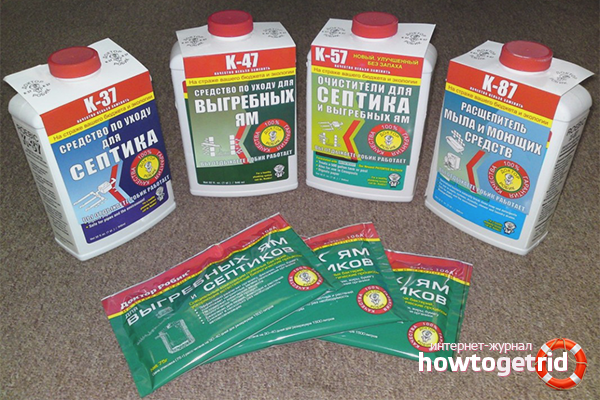
Popular antiseptics
Leading manufacturers of household chemicals have successfully developed and launched effective antiseptics on store shelves that will help get rid of the smell in the country toilet. Some preparations contain the so-called "biotal", which not only catalyzes the smell, but also acts as a flavoring agent. The disadvantage of this option for dealing with stench is considered to be a relatively high pricing policy, but for the most part it is justified.
- "Saneks" (Poland). The drug is produced mainly in the form of a powder, but you can also find a pressed composition. To prepare the solution, dilute Sanex in hot water according to the instructions, then pour into the pit/tank, close the lid. It is important that the amount of solution is proportional to the volume of the cesspool. In the next application, you will need 2 times less composition. Processing is carried out no more than 2 times a month.
- "Mikrozim Septi-Treat" (Russia). A biological product that is rightfully considered environmentally safe. It effectively neutralizes the smell in sewers and country toilets, while the product can be used at any temperature in both summer and winter. The main advantage of "Microzim" is that the treated fecal matter can be used as a fertilizer in the garden.
- "Atmos Bio" (France). The main feature of the drug is its high efficiency and cost-effectiveness. Products are produced in volumes of 0.5 kg. As a rule, one can is enough to process a cesspool for six months, sometimes longer. "Atmos Bio" prevents clogging of pipes, destroys crusts and sediments from fecal matter.
- "Bio Toilet" (Russia). The tool has a relatively low price category and belongs to the economy segment. It is available both in the form of tablets, and in the form of a powder, gel. The drug must be used once every 14 days according to the manufacturer's instructions. The analogues of the "Bio Toilet" are considered to be the preparations "Toilet Bucket", "Cesspool". This also includes the Domovo series, which is suitable for sewage wells.
- "Doctor Robik" (USA). The drug belongs to the category of bioactivators. It contains more than 7 effective "beneficial" bacteria that are able to break down and process household chemicals in sewers and waste in country toilets. To effectively treat the cavity with the composition, dilute the drug according to the instructions and pour it into the cavity. The frequency of processing depends on the time of year and temperature, so carefully read the manufacturer's recommendations. The smell does not disappear immediately, but only after a certain time (15-20 hours).
- "Devon N" (Russia). The action of the composition directly depends on the temperature in the toilet cubicle. In normal mode at + 25-27 degrees, you need to take 65 gr. product based on 1 liter of warm water. If the temperature is higher, the amount of gel / powder should be increased by 1.5-2 times. To use "Devon N" correctly, pour the final solution into a watering can and irrigate the surface of the fecal matter.
Method number 3. Folk remedies
Of course, chemicals are considered the most effective, but no one forbids you to use natural products. Tomato and nettle tops are considered effective.
The thing is that these products release special substances when they decompose. They kill germs and bacteria that cause bad breath. In addition, tomatoes and nettles absorb ammonia contained in the waste, and also repel insects.
To use tomatoes, throw the tops inside the cavity of the toilet, use a large amount of the product. If you prefer nettle, add it in the amount of 150-200 gr. 1 time in 8-10 days.
It is easy to get rid of the smell in the country toilet, if you have sufficient knowledge regarding the products available on the market. Visit the hardware supermarket, in the "Gardening" section you will find everything you need. Consider application folk remedies such as nettle and tomato haulm. Create artificial ventilation for more air circulation in the cabin.
Video: odorless country toilet
Eliminating odors in the country toilet is an urgent problem, especially in the summer. If you have such a problem, you need to check ventilation pipe- may be stuck. If ventilation was not done during construction, it must be done. It will take a little time and money, and there will be no intense smell in the room.
We do ventilation - natural and forced
Natural ventilation occurs due to the movement of air heated to different temperatures. In the toilet, for this, a window is made above the door, and holes in the side walls. It is advisable not to glass the window above the door, otherwise it will not fulfill its functions. To have fewer insects, it can be tightened with a net.
A window above the door - not only for lighting in the daytime, but also for ventilation
Side ventilation holes are made at the bottom. You can tighten it with the same mesh or install decorative grilles. The presence of holes different levels provides good air movement, which minimizes odor.
Also needed exhaust ventilation- a pipe from a cesspool or box, which has a waste container. The easiest way is to make it from a plastic pipe with a diameter of 100 mm. Its height should be 50-70 cm above the roof of the toilet. You will also need a 90 ° corner and an umbrella on top (or a deflector, if you find the right one) - so that foliage does not fly in.
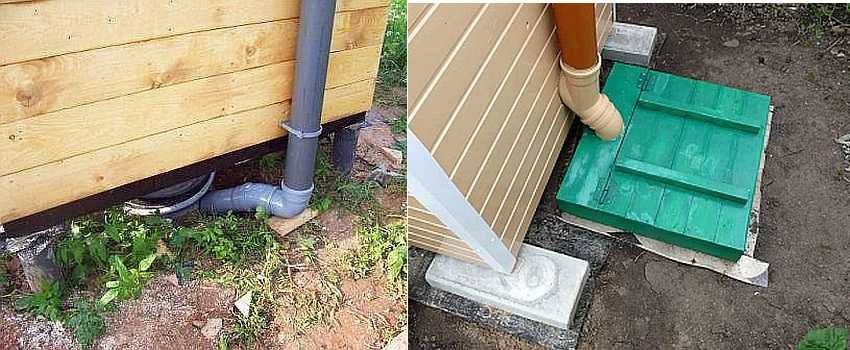
In the wall of the toilet, make a hole equal to the outer diameter of the pipe. Insert a short piece of pipe, mount a corner to it. All this can be fixed to the wall with clamps.
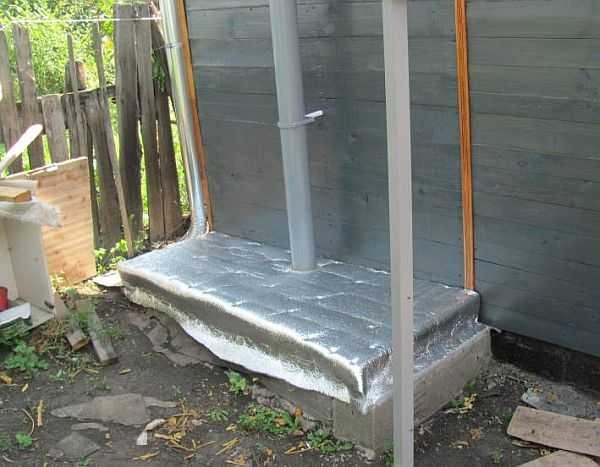
If you install a fan in the pipe, we get forced ventilation. If there is no fan - it will be natural - the movement of air will provide a temperature difference and wind.
Fighting methods
Unfortunately, the presence of ventilation is not a guarantee that there will be no smell. Its appearance is the result of even minor mistakes in the construction of the cesspool, as well as not the most successful location. Therefore, you have to deal with an unpleasant toilet smell and other methods.
store preparations
The industry produces special preparations to eliminate odors. They are available in liquid or bulk form, there are in the form of tablets. Bacteria are “packed” in these preparations, which process feces into completely harmless products - water and some kind of sediment. The result of processing almost does not smell of anything, and even more often it can be used as a fertilizer.
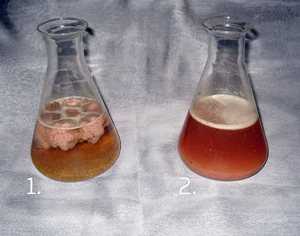
On the left, the contents of the cesspool before treatment with bacteria, on the right - after
There are three types of drugs:
- with anaerobic bacteria. They are insensitive to the presence of oxygen. Can be used in hermetically sealed containers. Their disadvantage is the release of hydrogen sulfide during processing, which means the presence of a characteristic odor. Also, these bacteria recycle approximately 7% of waste.
- Aerobic bacteria. They need oxygen to survive. They are used to process waste in cesspools. As a result of processing, silt settles at the bottom, which can be used as fertilizer, and water. Water can be used for technical purposes.
- Bioactivators. It is a mixture of two types of bacteria, supplemented with enzymes to speed up the processing process. This type of cleaner even copes with the processing of household chemicals.
Here are some remedies for the smell in the toilet in the country:

There are still a lot of drugs: in different forms (liquid, powder, tablets) and from different manufacturers. They are selected according to the composition of the prevailing waste. Basically, the recycling is efficient, there is no smell at all in the toilet, sometimes even a fragrance (BIOTAL) is present. The only drawback of this method of getting rid of toilet smell is the rather high price of drugs. And also the fact that bacteria are active only at positive temperatures.
Folk methods
Neutralizing the smell in the toilet in the country is possible without purchased drugs. There are at least two biological methods:
- Periodically add tomato tops to the cesspool.
- Once every 7-10 days, throw a bunch of nettles into the sewage.
Both of these plants, when decomposed, release substances that kill the bacteria that cause the "toilet" smell. The tops of a tomato (you can throw stepsons) at the same time also kills fly larvae, and also repels adult insects. So we get a double action - we eliminate the smell in the country toilet, and we get rid of the flies.
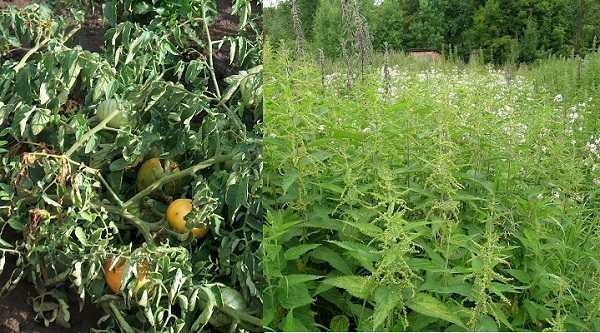
Dry toilets
The device of the cesspool is far from the most the best solution when building a toilet. Today, there are other ways to dispose of waste, which, if correct operation don't give off any odor at all. If you want to have an odorless country toilet, put a compost or peat toilet, which is also called a powder closet.
The essence of such a toilet is that after each visit, all waste is covered (powdered) with peat, sawdust, or a mixture of them. Small particles block contact with air, there is almost no smell. In the case of a cesspool, peat also works, but the volumes there are large and it is impossible to completely block access. Although with the regular addition of peat, the method works well.
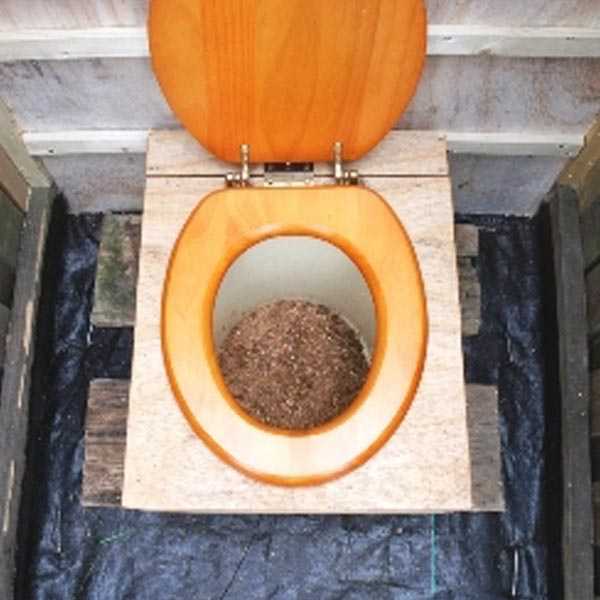
It's not a secret for anyone that a very unpleasant smell emanates from an outdoor toilet installed in a country house or on the territory of a private house. Of course, you can slightly reduce this problem by pumping the cesspool more often, but this process is quite costly. And yet there is a solution to this issue. Now let's try to figure out how to make a toilet for a summer house without smell and pumping out, what is required for this and how difficult such work is. In addition, it makes sense to understand how to save money on construction, at the expense of the future structure and its functionality.

There are several options for arranging an outdoor toilet that does not spread an unpleasant smell around. The main ones can be called:
- Installation of septic tanks (settlement wells);
- A method of installing a latrine without a cesspool, using peat;
- Additive to the pit for collecting sewage of various chemical liquids;
- Application of biomaterial, i.e. living bacteria that help the processing of waste products.
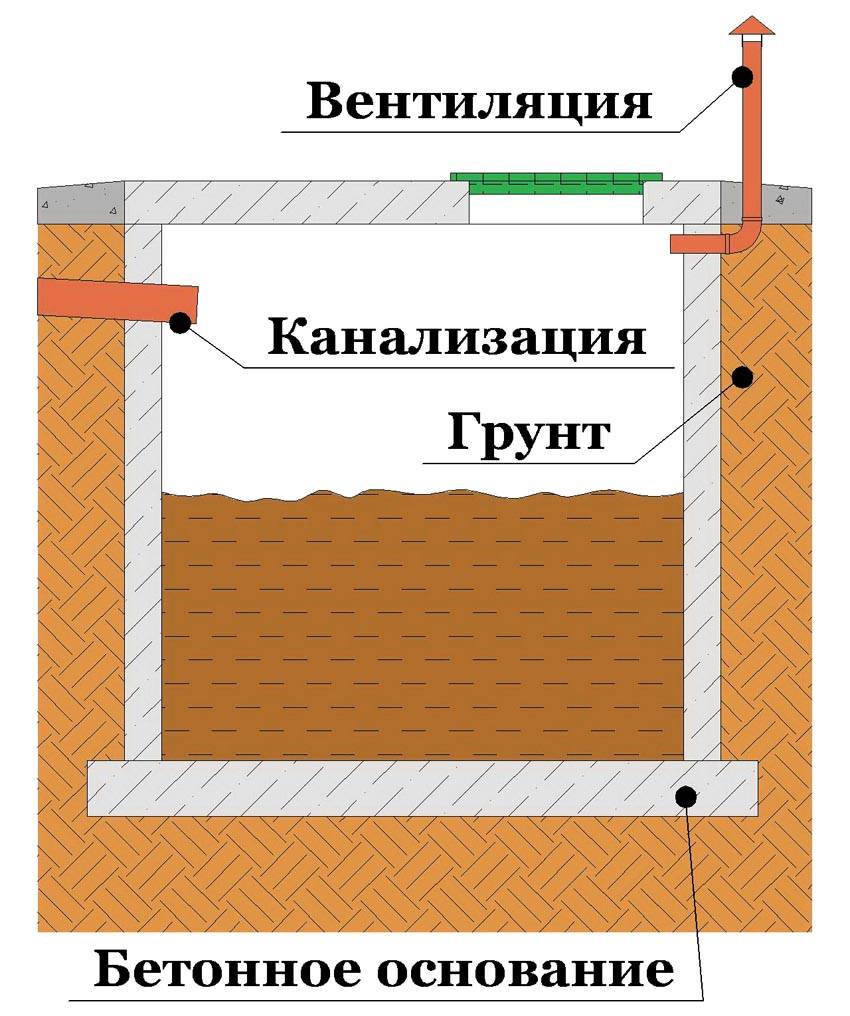
And, of course, the device is a good forced or natural ventilation. Right now, let's try to understand each of the ways to install an odorless toilet in the country with step-by-step explanations. The fact is that at times reducing the smell coming from the restroom (as well as inside it) is quite simple, but many do not know about it. It is enough, at the stage of installing the booth, to remove a ventilation pipe with a length of at least 3 m from the pit. Thus, due to natural draft, the smell will go through it without getting inside the building.
Important advice! The effectiveness of removing unpleasant odors directly depends on the length of the ventilation pipe. The higher it is, the better air draft it can create. Do not forget about the forced ventilation of the cabin.
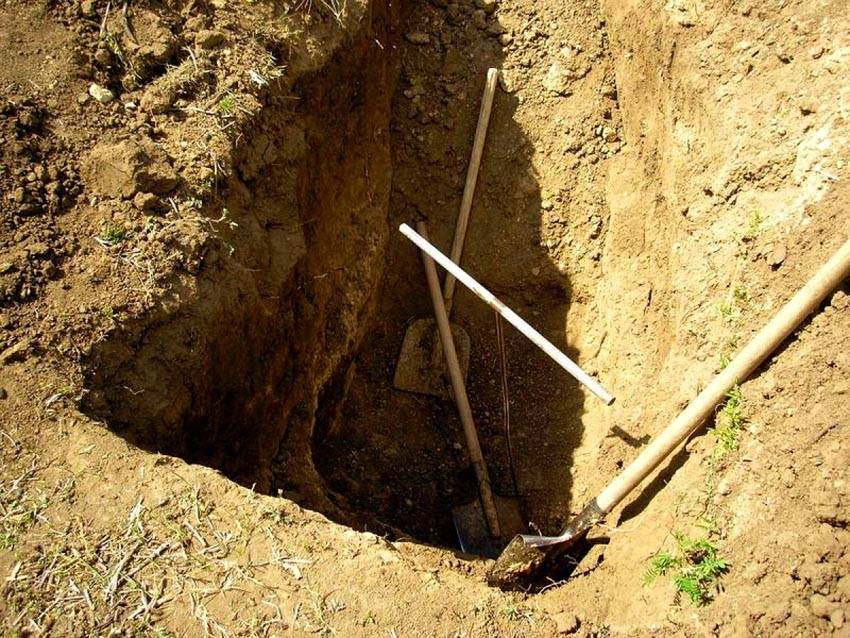
And yet, although in this case an odorless outdoor toilet will turn out, you will have to pump out sewage from the cesspool. So we will understand further what other methods will not require large expenditures, but at the same time they will be effective in solving this issue.
To dig or not a cesspool for a toilet in the country - is there a need for it
Many believe that without a cesspool, a street toilet cannot be built. But this statement is not entirely true. Of course, it is more common to have a toilet if it is available, but these days there are a lot of options in which it is not required. These are various bio- and chemical toilets, both factory-made and home-made, peat - processing human waste products into fertilizers necessary for their garden, etc.
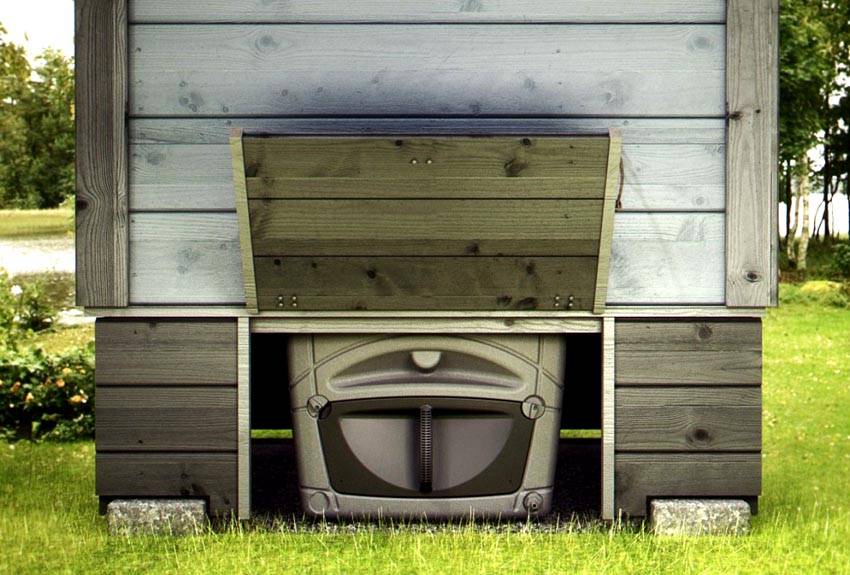
But, despite the convenience of installing such latrines, toilets with pits are the most popular. Moreover, many do not even think about pumping out, but simply, as they fill up, they fill up the old one and dig out a new one in another place, simply by moving the booth. And this is not surprising. After all, cleaning toilets and cesspools is a rather laborious, unpleasant and expensive process. Of course, if the farm has a small tank with a vacuum pump, as well as a place where the pumped out sewage is drained, then you can do this work yourself. But such equipment is rarely found in the household.
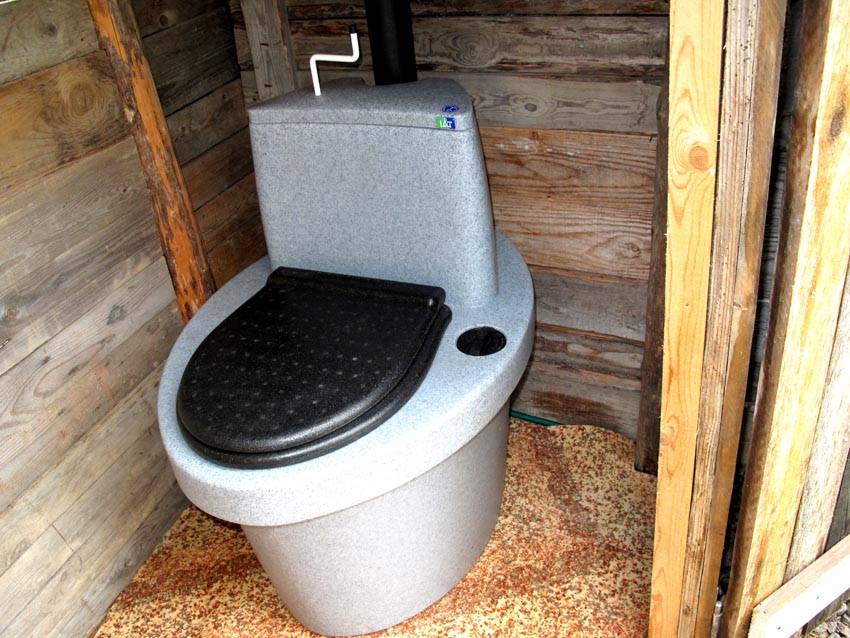
But it’s easier to dig a cesspool for a toilet in a country house with your own hands than to hire special equipment. Firstly, it will cost "a pretty penny", and secondly, the excavator can ruin appearance the site, stopping at it, and besides, the pit from the bucket will be sloppy, which will subsequently interfere with convenience when laying or installing its walls.
Important advice! Before starting work, it is necessary to thoroughly consider the ventilation and pumping device, as well as draw up a detailed drawing. Only in this case it is possible to install a country toilet with a cesspool, which will stand for many years without poisoning the existence of the household with an unpleasant smell.
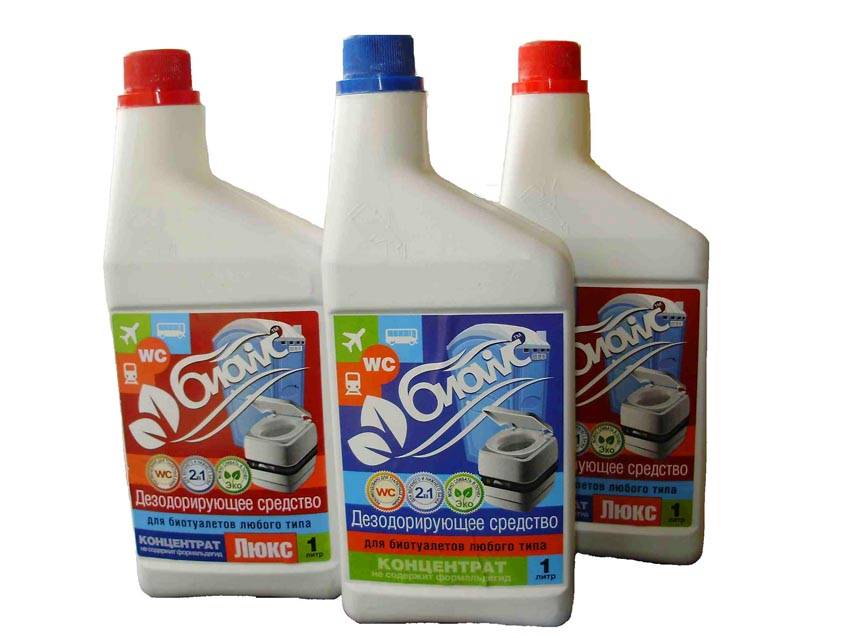
But ventilation is not the only way to get rid of the stench. There are many liquids based on chemical compounds or various live bacteria that help in the fight against it. It is on these methods of eliminating an unpleasant odor that we now dwell in more detail.
Related article:
We invite you to consider. Prices, user reviews, an overview of popular models will help you prioritize and make the right choice.
Overview of different brands of toilet and pit latrines and their prices on the Russian market
The desire for a more comfortable stay in the country in the summer, and even in private houses that do not have a centralized sewage system, pushes a person to buy various products and flavors for cesspools. And, as you know, demand creates supply, and therefore manufacturers of such mixtures and liquids are increasingly expanding their range on the shelves of Russian stores. Of course, they all differ from each other in cost and capabilities.
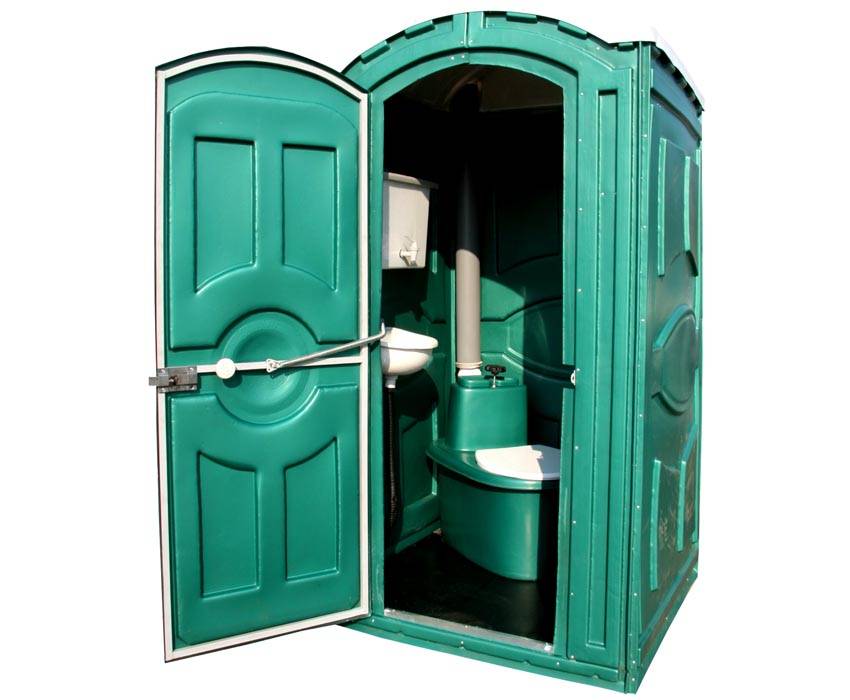
In order to have a general idea about these products, it is worth considering some of their brands, as well as comparing the prices set by the manufacturer.
| Cesspool brand | Compound | Beneficial features | Dosage for use | Average cost, rub. |
|---|---|---|---|---|
| BIO ELEMENTS 1813-03G | Biological microorganisms and bacteria | Decomposes sewage, reducing them in volume and processing them into nitrogen fertilizer | 15 g once a week (6 weeks pack) | 160 |
| MICROBEC ULTRA 822-01-23-3 | Biological microorganisms | Accelerates the process of decomposition of sewage, reduces volume, promotes cleaning of sewer pipes | 50 g per 4-7 m3 once a week | 100 |
| MICROBEC ULTRA TABS 822-01-1-2 | Biological microorganisms | Liquefies waste products, aromatizes | 2 tablets per 3 m3 once a week | 1280 for 40 tablets |
| NIOINONNO SDTNI-003 | Biological microorganisms | Gives a fresh aroma, prevents the spread of fungus, mold, etc. | 100 gr. 1 time per month | 7000 for 500 ml. |
| DEVON-N-025 | Biological microorganisms | Odor elimination | 0.25 l per week | 200 for 0.25 l |
| DEVON-IL 19791-098-1 | Nitrate oxidant | Eliminate odor, prevent silting of a septic tank | 100 ml 1 time per month. | 1000 for 1.5 l |
| Doctor Robik 309 | Safe chemical composition | Odor elimination, splitting of all types of waste products | 1 l 1 time per year | 1000 for 1 liter |
It turns out that when choosing such compositions, one should pay attention not only to the cost and composition, but also to the functions performed. Some products for cesspools and toilets in the country simply liquefy sewage for easier pumping, while others reduce the amount of waste, thereby helping to call the sewer machine less often, and therefore save money on paying for its work.
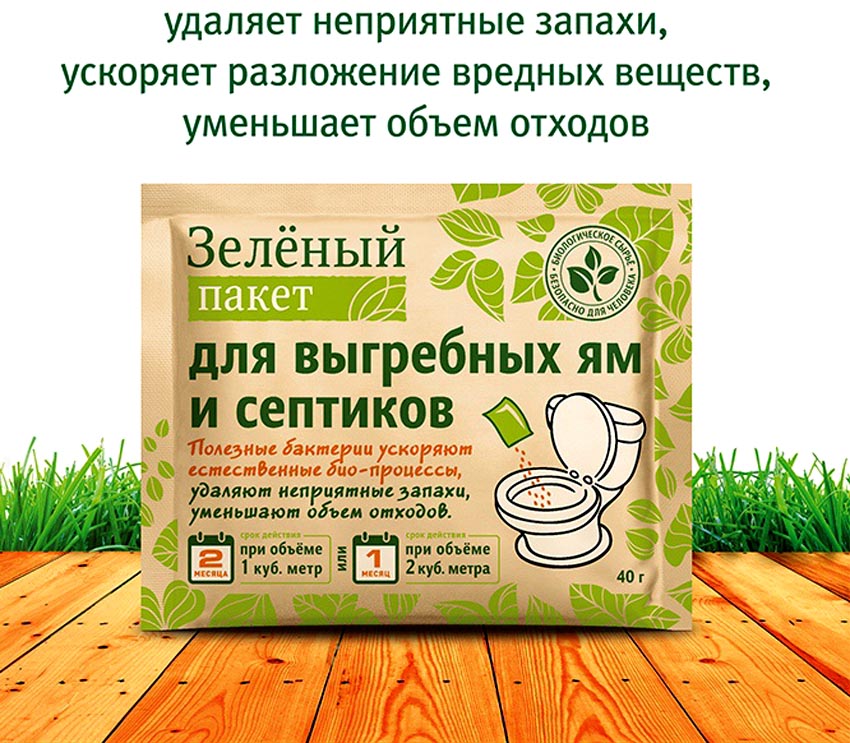
Important advice! If the choice is between chemical composition and biological, it would be much better to buy bacteria for cesspools. Even if the composition on such microorganisms must be applied more often. After all, fumes from chemicals (for example, based on formaldehyde) can adversely affect health, although there will be no smell from them.
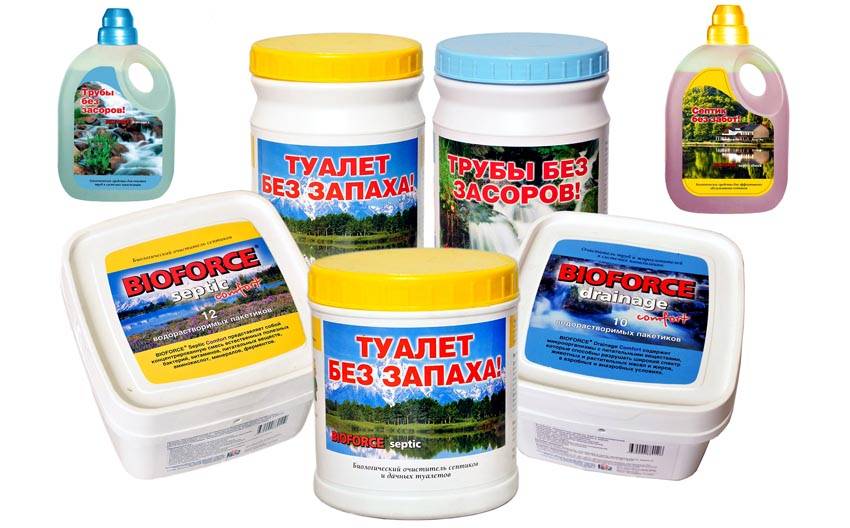
Biological preparations for cesspools in our time are quite common. Some of the manufacturing companies do not even start the production of chemicals, although it is more profitable, but they are profiled specifically for the manufacture of compounds based on live bacteria and microorganisms. And the advantage of such funds is not only in maintaining health (although, of course, this is the most important thing). Another plus is the possibility of using recycled sewage as an excellent fertilizer.
Important! Not processed by special microorganisms, human waste cannot be used as fertilizer - they are poisonous to plants and can kill them. The same applies to waste processed using formaldehyde compounds.
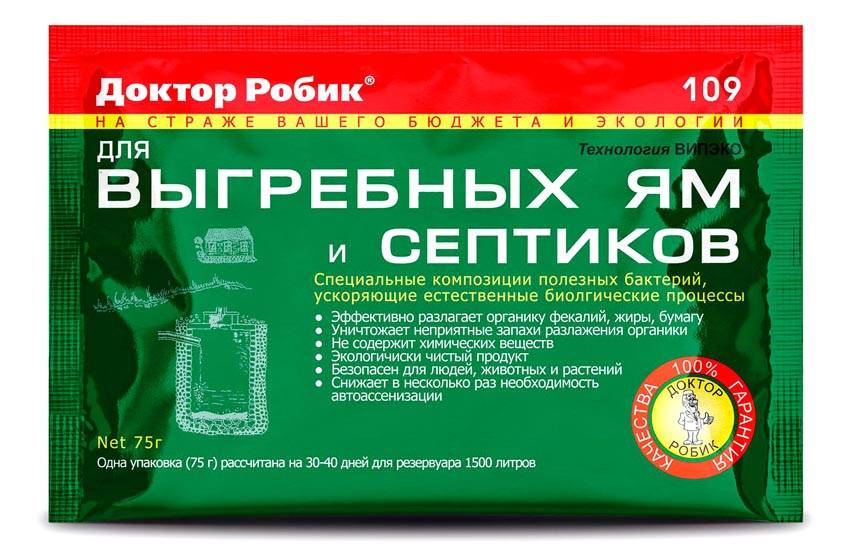
One of the most well-known products based on microorganisms and live bacteria is Doctor Robik for cesspools. Moreover, the compositions of this brand require a rather rare application. Also from this line you can pick up other liquids for a variety of purposes, up to cleaning pipes from both soaping and lime and other deposits.
How to install a toilet in a country house without a cesspool if its digging is not allowed according to SanPiN standards
According to the established sanitary norms and rules, it is not possible to construct a cesspool at every site. For example, it can be a fairly small area of land ownership or soil composition with a high content of shale. Yes, and too shallow a depth at which groundwater is located. In such a case, the only way out can be only a toilet in the country without a cesspool.
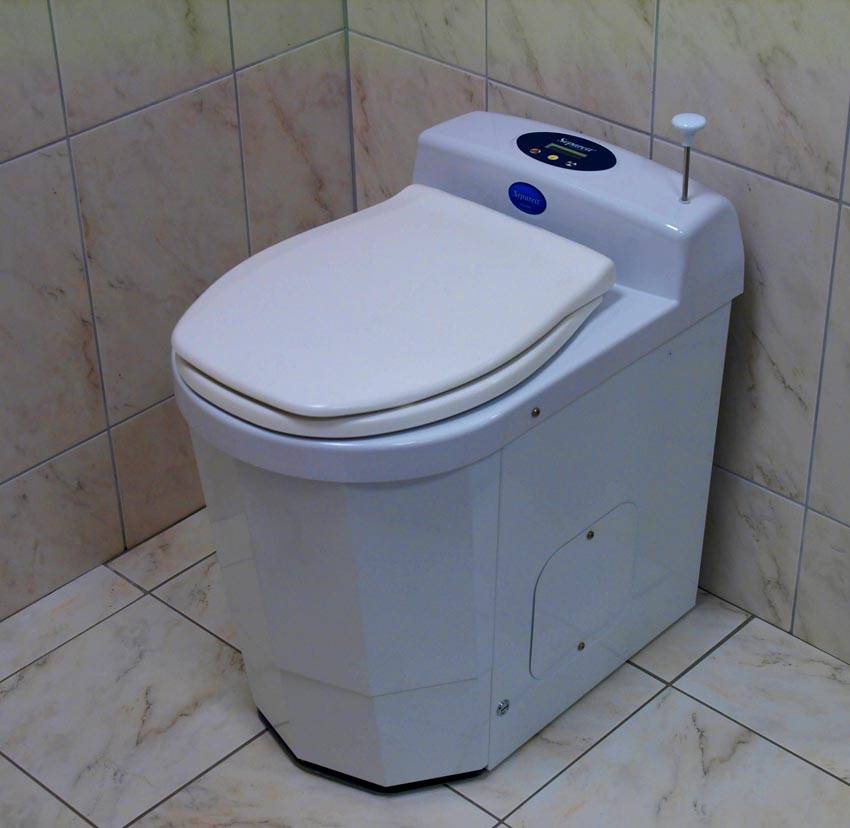
Let's try to understand how you can install such a restroom, what types they are and how many difficulties there are in such work, in comparison with installing a conventional outdoor toilet.
To begin with, we will define the possible types of such latrines. Among them are:
- Peat toilet;
- Dry closet with the use of chemical compositions;
- Dry closet with live bacteria and microorganisms.

Well, now it makes sense to figure out what each of these species is.
Factory or do-it-yourself peat toilet for a summer residence: which is better, a common device
Similar devices for processing human waste products can be found in any store of goods for the garden, vegetable garden and cottages. But still it will be more interesting to learn how to make a peat toilet with your own hands. To do this, you just need to understand the principle of its operation - the rest of the steps on its device are quite simple.
The simplest option would be a toilet cubicle, under the elevation of the seat of which there is an ordinary bucket. It is important to provide a door behind the restroom, from below, so that the container can be easily removed. After each visit to the toilet, you need to pour a little peat into the sewage tank. This will be the elementary performance of such a restroom.
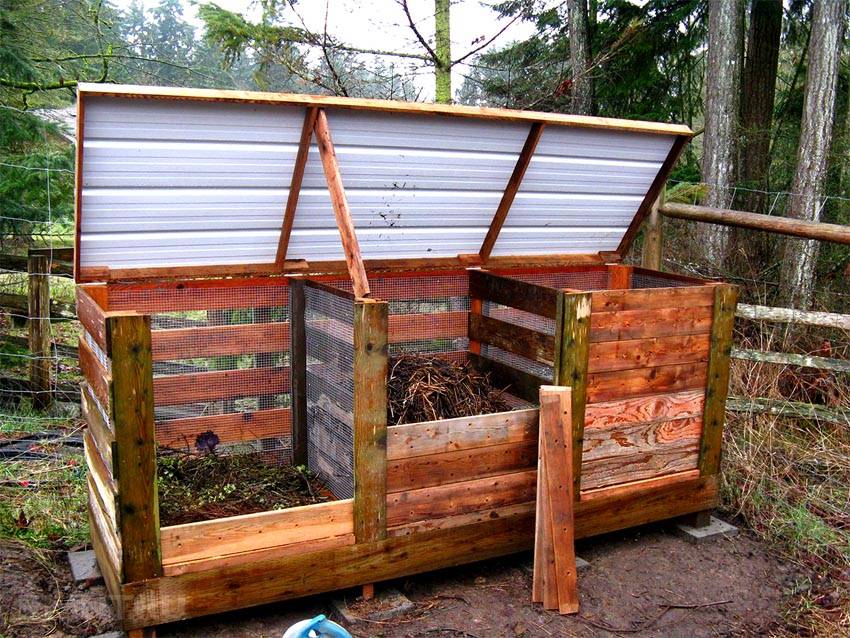
It's important to know! A filled container cannot be used as a fertilizer immediately. For the complete processing of waste products, it is necessary to choose a place for a compost pit or heap, where the waste will be processed for at least another year. At the same time, the time for the complete transformation of sewage into fertilizer depends on the temperature, and therefore it is preferable to use a pit.
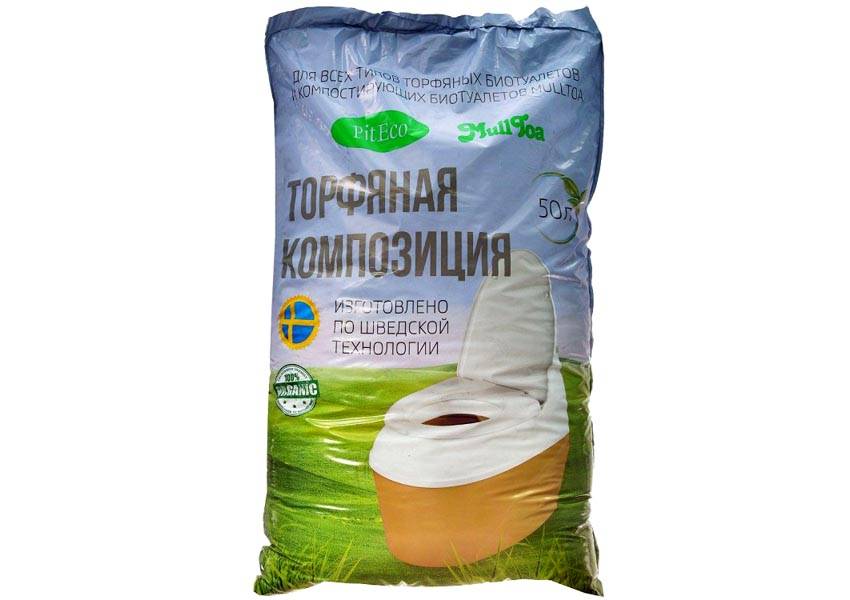
Peat for peat toilets can also be bought at any garden store. Its cost is low - on average it is 300 rubles. for 50 liters of raw materials - and therefore such latrines can be considered a fairly budget option. In addition, additional savings on pumping, the lack of effort to dig a hole and money for laying and strengthening its walls contribute to the growing popularity of such toilets in summer cottages, garden plots, and sometimes in use in private courtyards.
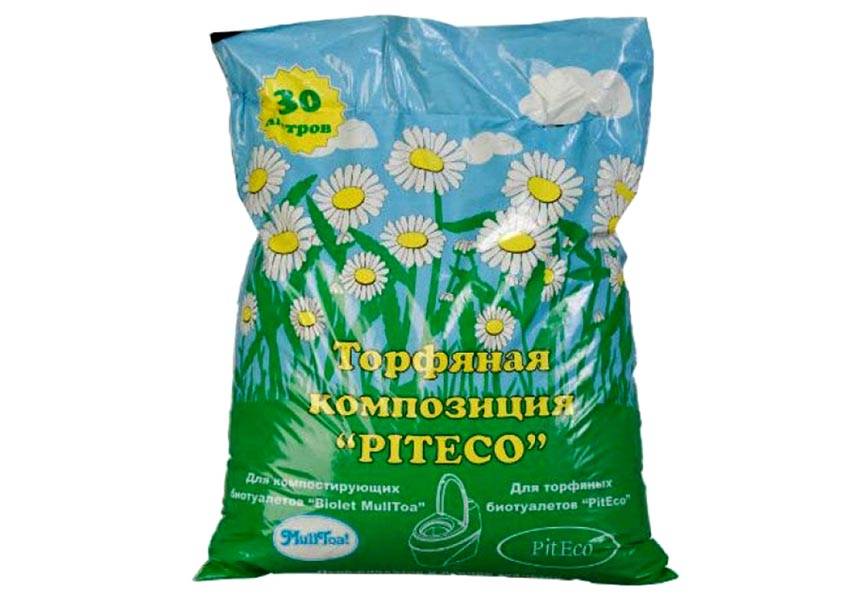
Of course, the need to dig a compost pit creates some inconvenience, but there is a good way out here. For a similar purpose, you can use ordinary metal or plastic barrels. To speed up the processing process, they are insulated with ordinary mineral wool. Moreover, a similar country peat toilet can be made inside the house, because. Such a filler perfectly absorbs unpleasant odors. Although, it will not hurt to install a fan in the home restroom with air outlet into the chimney or directly to the street.
Easy-to-use dry closet for giving without smell and pumping out: an overview and the possibilities of some types
Having considered some types of dry closets that are odorless and do not require pumping, you can make a small rating based on how sewage is processed in them, as well as paying attention to the cost. Of course, for the most part, such latrines require additional processing of waste products over a certain period, but there are also those from which ready-made fertilizer “comes out”.

| Type of toilet | Principle of operation | Approximate cost, rub. |
|---|---|---|
| Liquid dry closet for giving | In such latrines, natural microorganisms are used, which, in fact, "feed" on waste products. In addition to getting rid of unpleasant odors, waste is reduced in volume up to 5 times. Subsequently, the contents of the container are transferred to the compost pit, where the subsequent processing into fertilizer takes place. | From 5500 |
| Chemical country dry closet | Such a toilet, according to the principle of operation, is similar to a liquid one, but has its own cardinal difference. The spent composition from the tank cannot be processed into fertilizer, but requires special disposal, because. some chemical components of the compositions for this type of latrine may contain toxic, hazardous substances. | From 5300 |
| Electric dry closet | Electricity is used in it for ventilation, separation of waste into solid and liquid, and drying of solid sewage to the state of ash. When using free-flowing dry formulations based on microorganisms, processed waste products can be immediately used in the form of fertilizers. It is necessary to install a separate tank for liquid waste, which require subsequent disposal | From 15000 |
As you can understand, the difference in cost between chemical and liquid dry closets is insignificant, which is not surprising, because. they have the same principle of operation, and therefore it is quite acceptable to use one species as another. But as for the electric one, its cost is 3 times higher. In addition, such a restroom has some installation nuances. After all, this requires electricity, as well as at least some disposal of liquid waste, or drainage. Although the advantage, in the form of the absence of a compost pit, is obvious. That is why, before choosing a dry closet for a summer residence, you should think carefully about where and how it will be installed, provide for the possibility of summing up the necessary communications, and also evaluate your financial capabilities.
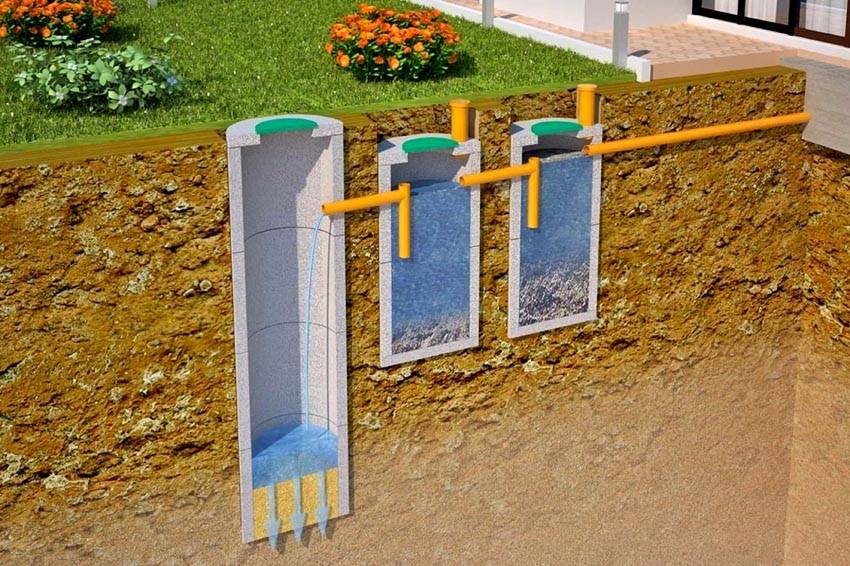
The device of a septic tank for a toilet in the country - step by step instructions
In order to be able to start step by step instructions septic tank devices, you should understand in general terms what it is and what it serves for. In fact, these are two or three wells of different levels, interconnected by a common sewer and arranged in series. Of course, for a small cottage, where the intensity of using the toilet and water is low, you can use one well, but such a septic tank will have to be pumped out more often.
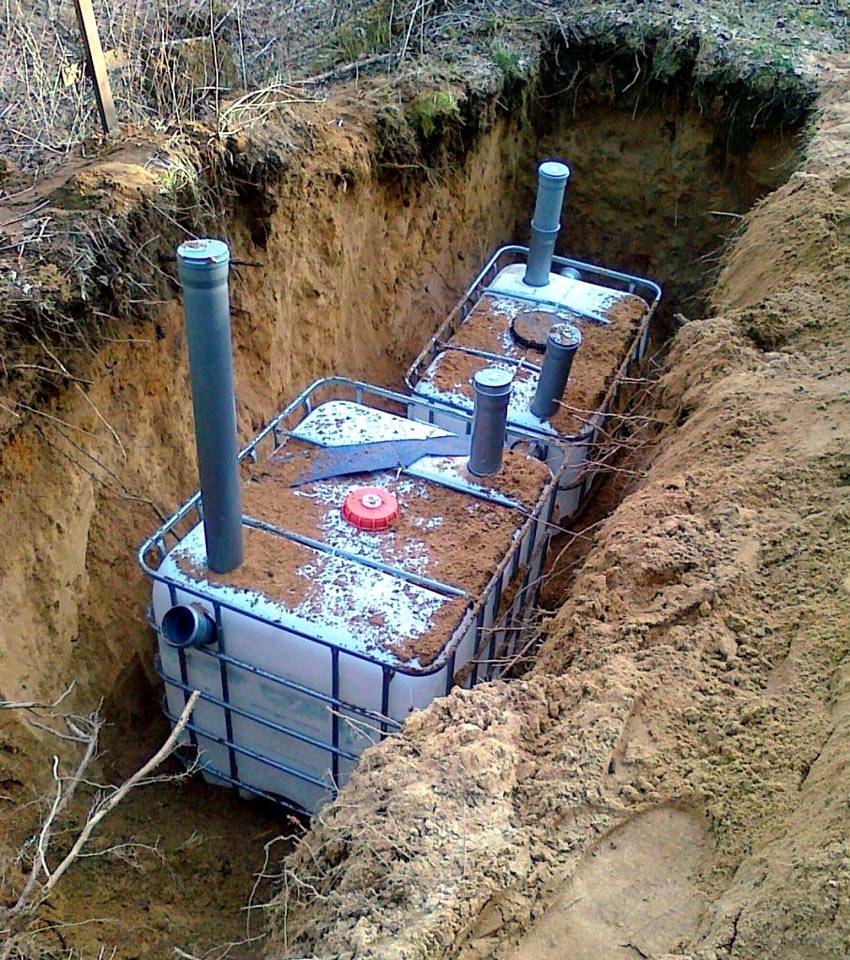
The most convenient scheme will be with the device of three wells, the last of which (the farthest from the drain) should be deeper. Let's make a reservation that the first two should have an airtight bottom, while the third one should have a pillow made of a layer of small and a layer of coarse gravel, which will provide additional filtration.
For example, it is necessary to arrange an autonomous sewage system to drain water from. You also need to install an odorless toilet in the room. A septic tank made of concrete rings in three wells, in this case, will be ideal. To do this, it is necessary to dig two holes in succession, two rings deep, and the third - four. The bottom of the first two, at the same time, will need to be poured with concrete, and the seams should be plastered, creating airtight containers. The bottom of the third well is covered with a layer of fine screenings, approximately 20-30 cm. Next comes the same layer of larger gravel. And finally, large gravel.
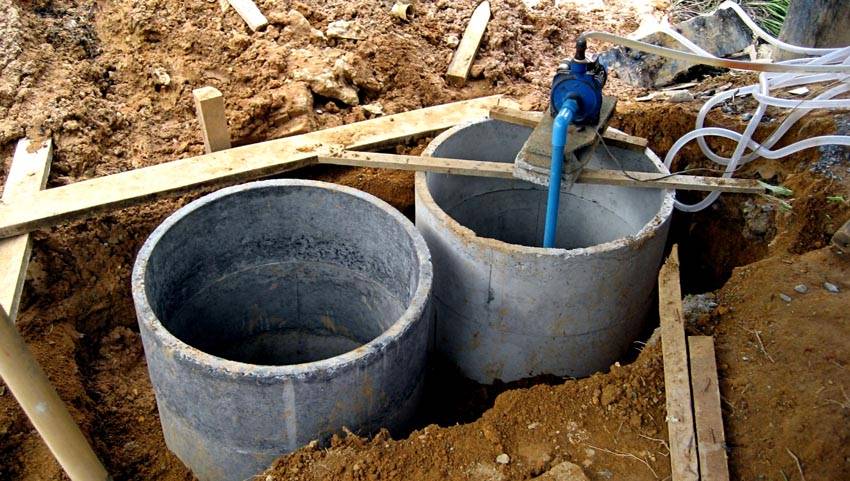
Containers are interconnected sewer pipes in the upper part, the drain is also mounted.
Important advice! In the first two sealed wells, it is necessary to periodically pour (or pour) mixtures or liquids on microorganisms that contribute to the breakdown of waste products and prevent silting.
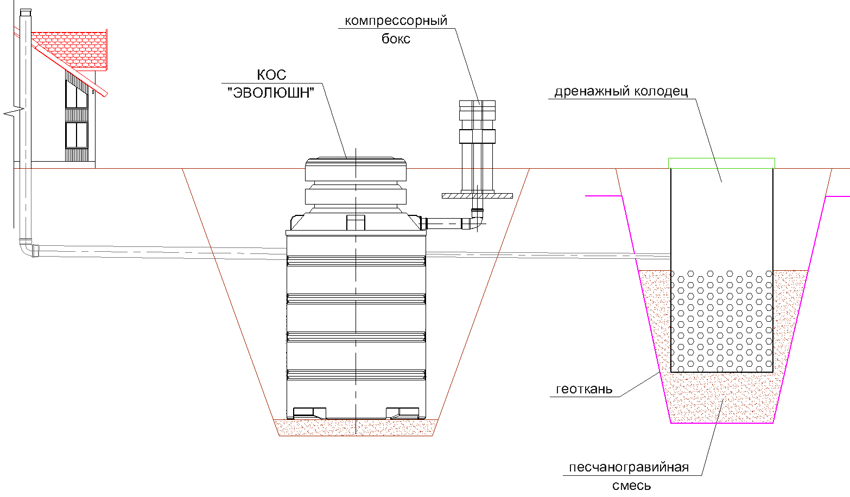
The described septic tank will function as follows:
- Sewage from the toilet enters the first well, in which solid waste settles to the bottom (where they are “attacked” by microorganisms that decompose them). This will be the primary, so-called. "rough" or rough cleaning.
- Next is the second well, where bacteria decompose the initially purified, liquid waste.
- The third well is already a sump, as such is not. The liquid, finally filtering through the gravel cushion, is absorbed into the ground.
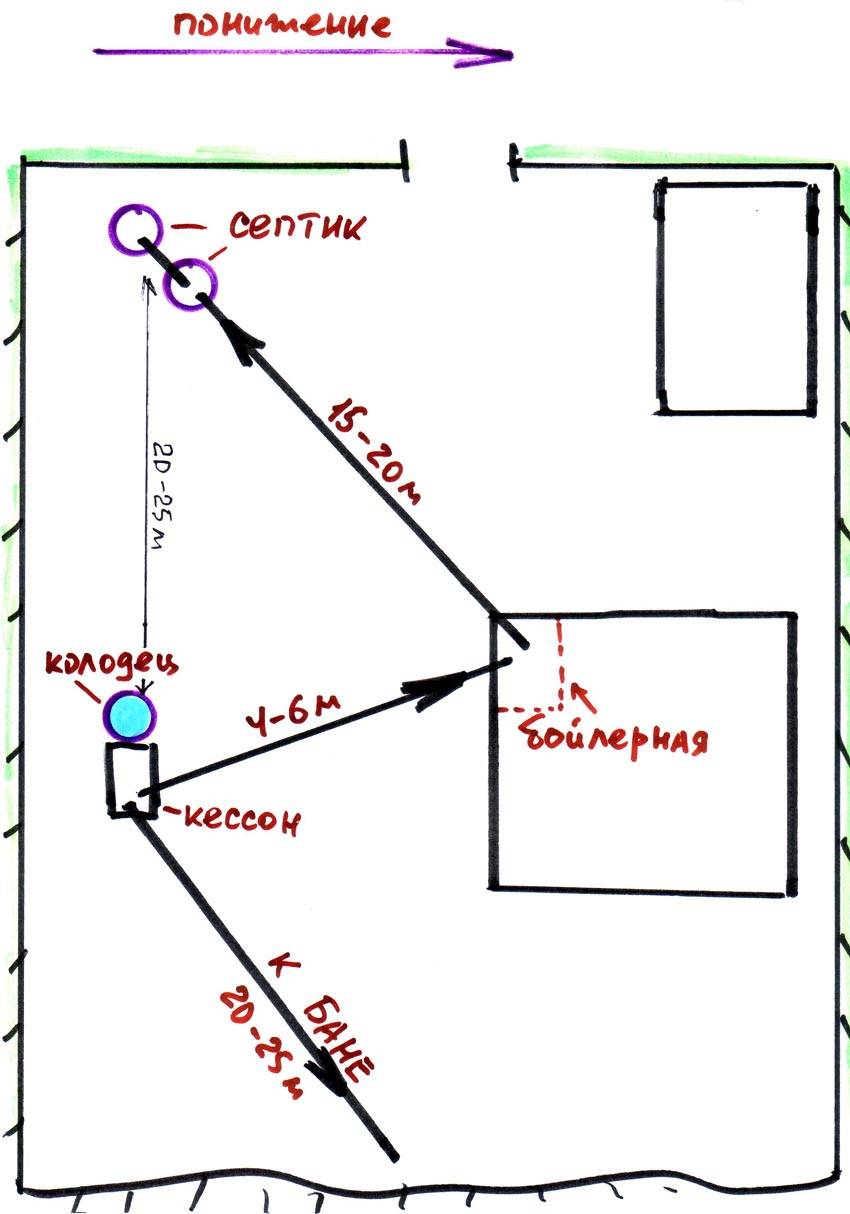
It is certainly clear that there should not be any special difficulties with the septic tank, but there may be plenty of “not special” ones. The main problem is accommodation in the local area, but everyone can deal with this personally. The main thing is not to forget about the ventilation of each of the wells, and the pipe must be at least 3 meters. This will get rid of the unpleasant smell in the yard. It is also necessary to provide for hatches, for the possibility, although rare, but sometimes necessary, of pumping out. Usually, the periods between cleanings are 10-15 years, but this period depends mainly on the quality and intensity of the use of substances for the decomposition of sewage, the range of which, on the shelves, is very large.
Because the device of a septic tank is a rather complicated process, we suggest watching a short video instruction for its installation /
Video: do-it-yourself septic tank
What material can the toilet cubicle be made of?
Having dealt with cesspools, septic tanks and other communications, you can proceed to the construction of the toilet cubicle itself. First you need to decide what material the toilet will be made of, because. it can be made both wooden and from corrugated board, plastic panels, from plywood or chipboard. Of course, the most common are wooden latrines. Let's take a look at what these structures look like.
And this is the work of craftsmen, in which the only limitation is the level of imagination.
A good option is a rented plastic toilet for a summer residence.
If only summertime is spent in the country house, you should think about renting a plastic toilet for the country house, which will be maintained by the rental company. In this case, all that is needed is to conclude an agreement, specifying the frequency of maintenance, and also choose a place on the site, leveling the surface. In this case, the company itself will deliver the booth at the beginning of summer, will periodically pump out the reservoir, and in the fall will take the restroom, which will save the summer resident from all the troubles associated with maintaining the restroom.
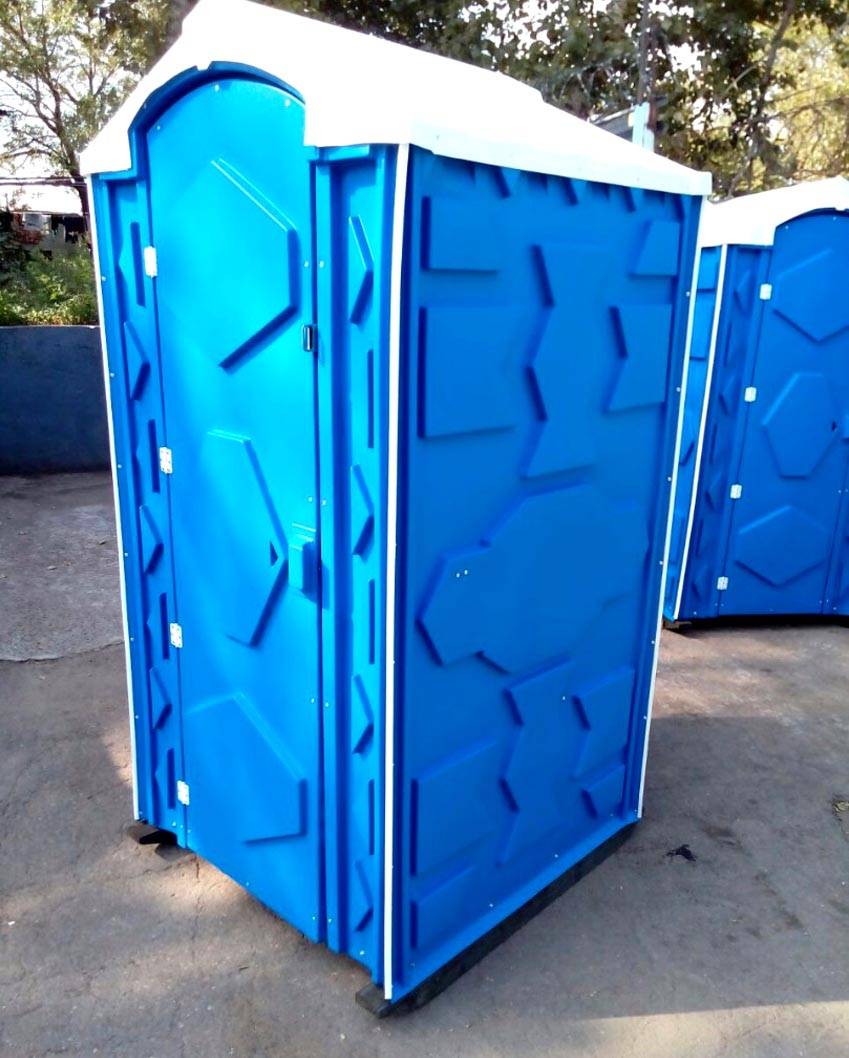
For example, the cost of renting a cabin for a month with weekly maintenance will be about 5,500 rubles.
Do-it-yourself toilets in the country from barrels: what difficulties can there be?
If a rather rare use is expected, then you can get by with a small toilet pit in the country, in which you will need to install a plastic barrel without a bottom. It will serve as a reservoir in which solid waste accumulates. Liquid ones will soak into the ground.
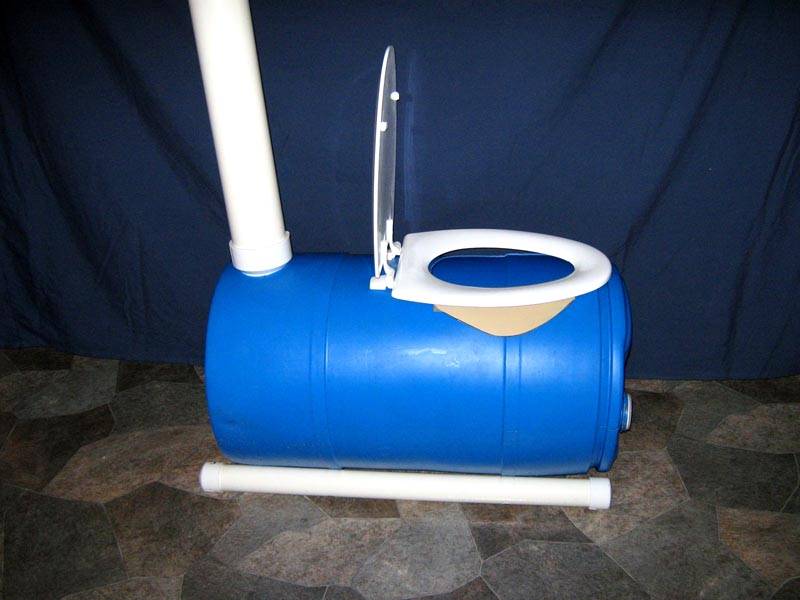
Important advice! When using barrels without a bottom for a toilet in the country, do not neglect liquids for cesspools. Otherwise, an unpleasant smell will be felt around, because. high-quality ventilation in this case, it is unlikely to succeed.
What can be done from concrete rings for a summer residence: a toilet on a "capital" pit
Subject to more frequent use of the restroom, the cost of concrete rings will be quite justified. The country toilet, in this case, can be equipped with good ventilation, including forced ventilation. Otherwise, there is no difference in installation with the previous version.
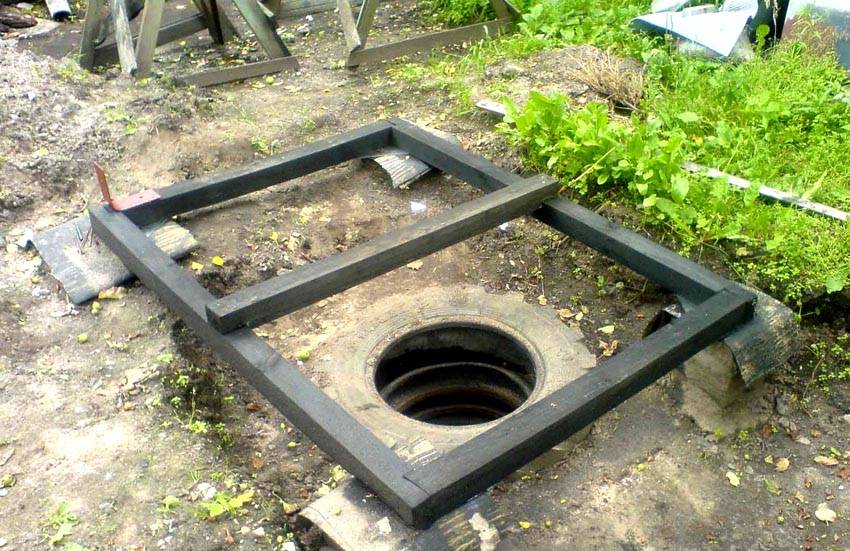
Toilet for a summer residence - buy or build? The question is difficult, but solvable
For many, construction, even as small as erecting a toilet cubicle, becomes an impossible test. In this case, you can simply purchase a ready-made dry closet by installing it inside the house. Naturally, it is desirable that he be in a separate room. We have already dwelled on their cost, and therefore it makes sense to understand which one is more convenient for an internal installation.
The most optimal would be an electric dry closet, the removal of fluid from which is easy to bring to the street. Provided that two or three people will use it, its reservoir is unlikely to be filled over the summer.
A peat toilet for a summer residence, which can be bought much cheaper, is also quite convenient to use. Its factory version includes a peat tank with a handle. Those. after use, you just need to turn the knob one turn, and required amount filler is poured into the reservoir. Containers for sewage in such latrines can be different - it all depends on the number of people in the house.
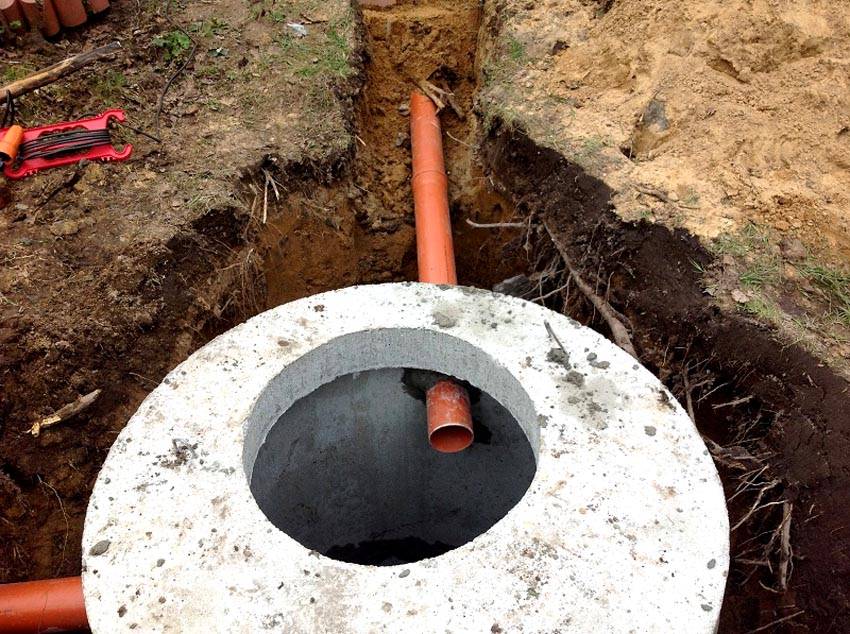
In any case, you need to understand that you won’t be able to buy a good toilet for a summer residence cheaply, because. quality always costs money.
Important advice! To choose a really good factory-made product, you need to pay attention to the reviews, the prices of dry closets for summer cottages and their characteristics. Only then can you choose the perfect option.
Preparatory work before making the toilet in the country odorless. Consolidation of general information
Preparatory work has always been the basis of any business. That is why it is worth once again, in general terms, to recall the steps preceding construction:
- Drawing up a preliminary drawing;
- Thinking and fixing on the drawing of a country toilet, ventilation system;
- Digging a cesspool in size and strengthening its walls;
- Installation of an elementary foundation for a country toilet;
- Installation of ventilation and floor of the future building;
- Assembling the cabin frame on the foundation;
- Sheathing walls, roofs, hanging doors.
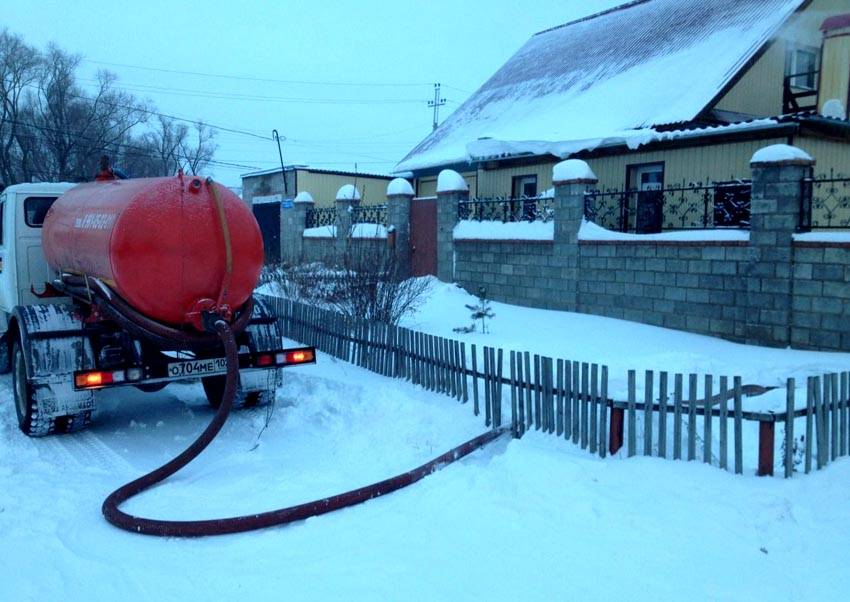
If you fully understand the algorithm of actions, it becomes clear that an odorless country toilet with your own hands is not such a difficult task.
What is the cost of pumping out toilets in the country and is it necessary to call a car
No matter how much you want to save money on pumping out a cesspool, sooner or later you will have to do it. It is unrealistic to perform such a procedure with your own hands (this was already mentioned earlier), which means that someday you will need to pay professionals for this action.
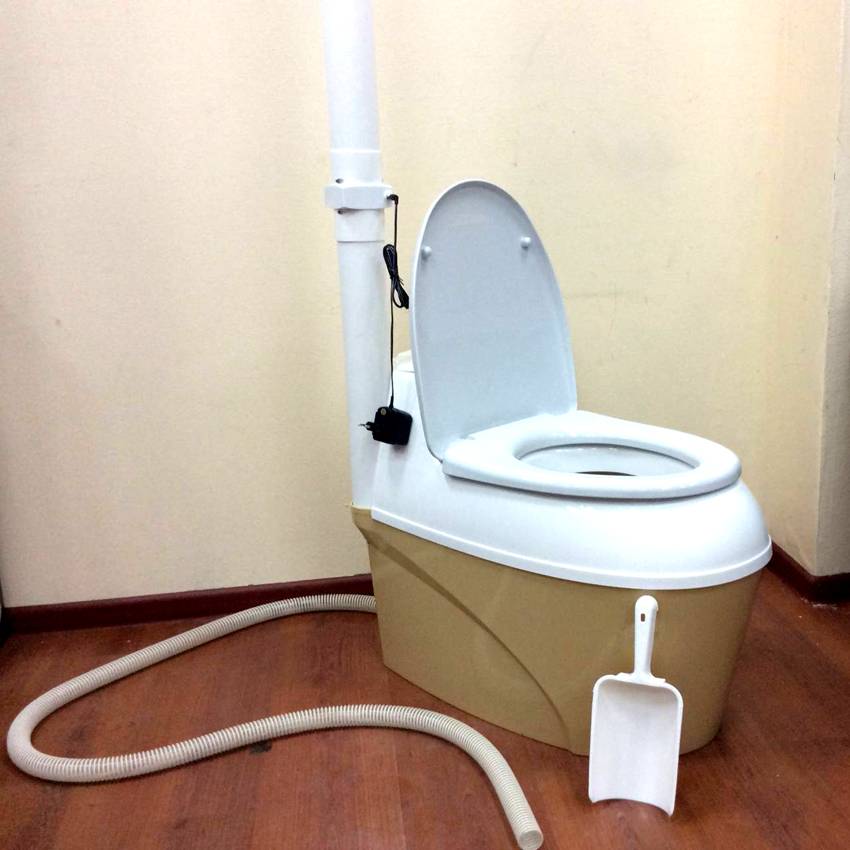
As for the cost of pumping out toilets in private homes, such cleaning with a sewage machine with a volume of 4 m 3 of sewage will cost, on average, almost 4000 rubles. (Costs may vary by region). It is for this reason that it is recommended to use substances that reduce the volume of waste products. In this case, pumping out the toilet in the country will be required much less frequently.
Instead of an afterword
It does not matter which version of the country toilet without pumping and smell is chosen for operation. And it does not matter if it is made by hand or in the factory. The most important thing is that he performs all the functions and tasks that are assigned to him. Well, the frequency of maintenance, the installation site and the use of special mixtures and liquids (as well as their composition) is already a personal matter for everyone. And for that, and advice on this matter can not be.
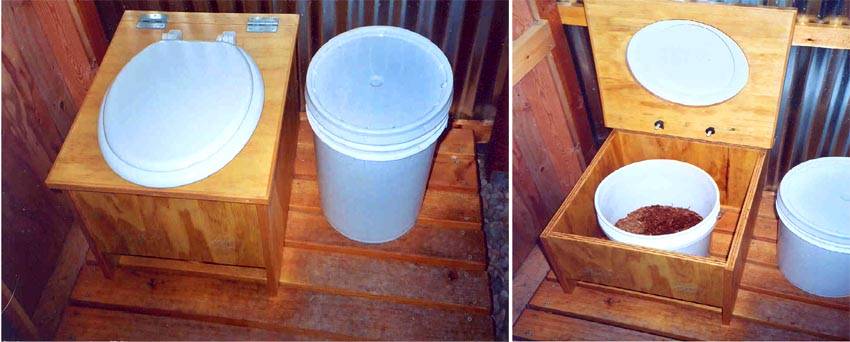
Still, some generalizations are worth making. For example, if there is no desire to install a toilet, or the state of health does not allow, and besides, and a person spends only the summer months in the country, the option of renting a plastic dry closet cabin can be very convenient. At the same time, its service is also provided, i.e. pumping, washing, etc., up to 4 times a month.
If you want the pumping to be rare, and the toilet to be capital, it is worth considering a septic tank from two or three wells. Well, subject to infrequent use, a peat dry closet will be quite convenient, which can be installed both outdoors and indoors. In addition, pumping, and hence the cost of funds for it, he does not require.



